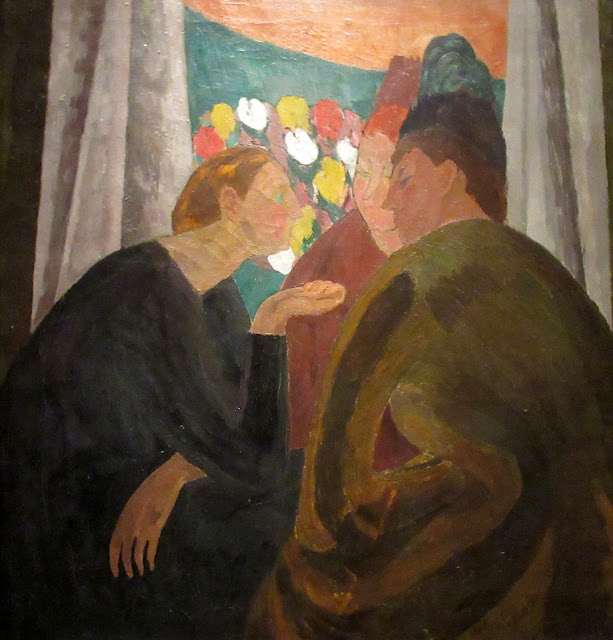A few paintings by the Bloomsbury Group, whose members were some of the most radical artists, writers and intellecturals of the early 20th century. From about 1910, this close-knit circle began challenging the conservative values of the British establishment, embracing freedom of artistic expression and upturning social and sexual norms. They became known as the Bloomsbury Group after the area in London where they lived and worked. Their most famous member was Virginia Woolf. Among the prominent artists of the group were her sister Vanessa Bell, Duncan Grant and Roger Fry. Best known as an influential art critic, Fry introduced French Impressionist and Post-Impressionist art to a London audience with two important exhibitions in 1910 and 1912.
Roger Fry, Portrait of Nina Hammett, 1917, (oil on canvas)
Bold colours and simplified shapes depict three women in deep conversation. The painting's strong visual impact suggests the discussion is of great significance, although we are left to imagine the subject matter. Perhaps Bell was paying tribute to the friendship and debate the Bloomsbury Group found so vital.
Bell produced some of the most innovative paintings of the period. Her painting Strudland Beach, one of my top favourite paintings, and one that I never tire to look at, has been described 'in its move towards abstraction as ... one of the most radical works of the time in England'. You can read see it and read more about it here
You can also see more of her work here
Duncan Grant, Seated Woman, Ka Cox, 1912, (oil on wooden panel)
Roger Fry, Blythburgh, The Estuary, 1892-93, (oil on canvas)
With its rhythm of dark trees against a watery twilit landscape, the painting reflects Fry's interest at the time in the European movement known as Symbolism, in which mood and mystery are expressed through a flattening of shapes.
Frederick Etchells, The Hip Bath, 1911-12, (oil on canvas)
The stylised figure, the strange flattening of the bath and the unfinished appearance offended conventional taste and Etchells was accused by one critic of setting out to 'merely play the clown and lose all sense of responsibility'.






No comments:
Post a Comment